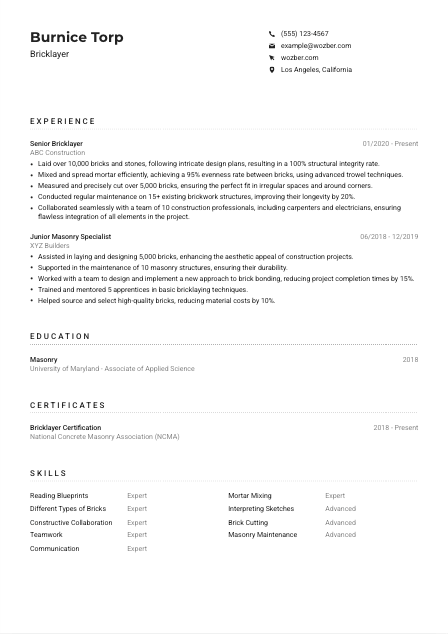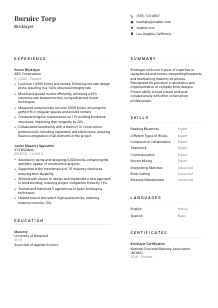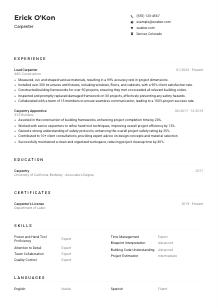Bricklayer Resume Example
Laying bricks, but your resume feels like a pile of rubble? Set the foundation for success with this Bricklayer resume example, laid out using Wozber free resume builder. Discover how to stack your masonry skills to meet job requirements, and build a career as solid as the walls you construct!

How to write a Bricklayer Resume?
Hello, future Bricklayer maestro! In today's competitive job market, standing out as a candidate requires more than just meeting the basic qualifications. Your resume is not just a document; it's your personal billboard, showcasing your professional prowess. Armed with Wozber's free resume builder, you're about to navigate the art of tailoring your resume to fit the Bricklayer position snugly.
Let's not lay another brick without ensuring your resume foundations are solid and optimized for Applicant Tracking Systems (ATS). Ready to chisel away? Let's sculpt your resume into a masterpiece that lands you the job!
Personal Details
The Personal Details section sets the stage for your professional story. It might seem straightforward, but this is your first handshake with potential employers. Fine-tuning this section to suit the Bricklayer job requirements is key to getting noticed.
1. Clearly Display Your Name
Your name is not just a label; it's the headline of your professional saga. Ensure it's prominently placed at the top of your resume, using a clean, professional font. This positioning instantly grabs attention and brands your resume.
2. Precisely Match Your Job Title
Right below your name, specify your professional title. In this case, "Bricklayer". This tells the hiring manager at a glance that you're in the right ballpark. It's a simple yet powerful alignment with the job you're eyeing.
3. Include Essential Contact Info
Your phone number and professional email address are your primary channels for potential callbacks. Use a professional format for your email, ideally firstname.lastname@email.com, to maintain a polished image.
4. State Your Location
"Located in Los Angeles, California" - this phrase alone matches one of the job's key requirements, demonstrating upfront that you're a logistical fit. Plus, it reassures employers there's no need to worry about relocation issues.
5. Add a Professional Link
If you have a LinkedIn profile or a personal website showcasing your masonry projects, include it. Make sure it's up-to-date and complements your resume. It's like showing your digital portfolio even before you're asked.
Takeaway
Think of the Personal Details section as the cornerstone of your resume. It's brief yet impactful, setting a professional tone. Keep it straightforward and aligned with the Bricklayer role to pave your way toward a strong first impression.





Experience
The Experience section is where your resume starts to take shape, brick by brick. For a Bricklayer, showcasing your craftsmanship, projects, and collaborations is crucial to displaying your qualifications.
- Laid over 10,000 bricks and stones, following intricate design plans, resulting in a 100% structural integrity rate.
- Mixed and spread mortar efficiently, achieving a 95% evenness rate between bricks, using advanced trowel techniques.
- Measured and precisely cut over 5,000 bricks, ensuring the perfect fit in irregular spaces and around corners.
- Conducted regular maintenance on 15+ existing brickwork structures, improving their longevity by 20%.
- Collaborated seamlessly with a team of 10 construction professionals, including carpenters and electricians, ensuring flawless integration of all elements in the project.
- Assisted in laying and designing 5,000 bricks, enhancing the aesthetic appeal of construction projects.
- Supported in the maintenance of 10 masonry structures, ensuring their durability.
- Worked with a team to design and implement a new approach to brick bonding, reducing project completion times by 15%.
- Trained and mentored 5 apprentices in basic bricklaying techniques.
- Helped source and select high‑quality bricks, reducing material costs by 10%.
1. Highlight Relevant Experience
Begin by breaking down your past roles. If you've contributed to a project ensuring "100% structural integrity", that's a golden nugget. It directly reflects your adherence to quality and standards—major plus points for your potential employer.
2. Use Role and Company Structure
Present your experiences in reverse-chronological order, with your latest job first. Ensure each role listed is relevant to the Bricklayer position, outlining your title, the company name, and dates of employment for clarity.
3. Detail Your Achievements
Each role should have bulleted accomplishments that mirror the job's demands. If you've "Mixed and spread mortar with a 95% evenness rate", showcase it. It's a testament to your skills and precision, addressing specific job requirements.
4. Quantify Your Impact
Numbers make your accomplishments tangible. Whether it's the "10,000 bricks laid" or "15+ structures maintained", quantifying your work provides a credible, measurable impact of your contributions.
5. Focus on Relevance
While variety in experience is great, tailor your content to the job at hand. If particular tasks or projects align closely with the responsibilities of the Bricklayer role, they deserve a spotlight on your resume.
Takeaway
Construct your experience section with care. Make each point a testament to your skills and qualifications for the Bricklayer position. Remember, it's not just about what you've done, but how what you've done makes you the ideal candidate for the role. Aim to demonstrate your expertise through clear, quantifiable achievements.
Education
Even though hands-on experience often takes center stage for Bricklayer positions, don't underestimate the foundation a solid educational background provides. Let's mortar in your academic achievements.
1. Meet the Basic Requirements
Though the job description didn't specify a degree, listing your relevant educational background, such as an "Associate of Applied Science in Masonry", demonstrates formal training and foundational knowledge in the craft.
2. Keep the Structure Simple
Format this section for easy reading. List your degree, the institution, and your graduation year. It's straightforward but effective, laying out your educational foundation clearly.
3. Tailor to the Job's Needs
Specific courses or certifications, like the "Bricklayer Certification", resonate strongly with job requirements. Highlighting this shows you're not just qualified but also committed to professional standards.
4. Mention Relevant Courses
If you've taken courses directly relevant to bricklaying or construction, list them. This could include specialized training in blueprints reading or historical masonry techniques, further proving your expertise.
5. Showcase Other Achievements
Academic honors, relevant extracurricular activities, or projects can also be included, especially for newer professionals. They paint a picture of a well-rounded candidate passionate about their craft.
Takeaway
Your education section lays the groundwork of your professional identity. Highlighting relevant degrees, courses, and certifications positions you as a well-prepared candidate, ready to bring your theoretical knowledge into the practical world of bricklaying.
Certificates
Certifications are like the cement that binds your qualifications together, providing proof of your specialized skills and commitment to your craft. Let's brick in this section with precision.
1. Identify Key Certifications
Starting with the most relevant certification, like the "Bricklayer Certification", directly answers the job's call for a certified professional. It's a clear, strong indicator of your qualifications.
2. List Pertinent Certifications First
Quality trumps quantity. Highlight certifications that resonate most with the job requirements. This focused approach ensures that the hiring manager immediately sees the value you bring.
3. Include Dates
If your certification is recent or has an expiry date, mention it. This shows your commitment to staying updated in your field. For ongoing certifications, a note like "2018 - Present" clarifies your current standing.
4. Regularly Update
The construction world evolves, and so should your certifications. Stay ahead by pursuing continuous learning opportunities. It not only boosts your resume but also keeps you sharp and informed on the latest in bricklaying techniques and safety standards.
Takeaway
Your certifications section should stand as a testament to your specialized knowledge and ongoing commitment to excellence in the bricklaying profession. It's not just about meeting requirements; it's about showcasing your dedication to being the best in your field.
Skills
The Skills section is your professional toolkit. For a Bricklayer, it's about striking the right balance between hard skills like "Reading Blueprints" and soft skills such as "Teamwork". Let's chisel out your skills with precision.
1. Match Job Description
Scour the job description for desired skills. Incorporating skills like "Mortar Mixing" and "Interpreting Sketches" directly from the job listing ensures your resume speaks the same language as your potential employer.
2. Balance Hard and Soft Skills
While the technical know-how of different types of bricks is critical, don't overlook the importance of collaboration and effective communication within your team. This blend paints you as a well-rounded candidate.
3. Organize for Impact
Position your most relevant skills at the top. This strategic placement ensures the hiring manager sees your most potent and applicable skills first, making a compelling case for your candidacy right off the bat.
Takeaway
Your skills showcase is a compact, yet powerful section of your resume. Tailoring it to the role you're applying for by aligning it closely with the job description ensures you're presenting yourself as the perfect toolkit for the job. Keep it clear, balanced, and relevant.
Languages
In the diverse landscape of construction, communicating effectively in English is paramount, but additional languages can also be a boon. Showcasing your linguistic prowess can be a subtle asset that sets you apart.
1. Fulfill Basic Requirements
"Ability to perform job duties in English is essential." Featuring your proficiency in English at the top assures hiring managers of your ability to effectively communicate and understand project specifications.
2. List Additional Languages
If you're multilingual, this is the place to highlight it. While the job might not demand it, being able to communicate in another language showcases versatility, especially in regions with a diverse workforce.
3. Be Honest and Clear
Clearly indicate your level of proficiency for each language listed. Using terms like "Native", "Fluent", "Intermediate", or "Basic" gives a straightforward understanding of your capabilities.
4. Assess the Role's Scope
In a role like Bricklaying, direct communication is mostly in English. However, for projects involving a diverse team, indicating your language skills can make you an invaluable link within the team.
5. Language as a Bridge
Think of every language you speak as a bridge to stronger collaborations and broader understanding. Your resume reflects not just your bricklaying skills but also your ability to integrate into diverse teams with ease.
Takeaway
Highlighting your language skills isn't just about ticking a box; it's about illustrating your readiness to engage and collaborate in a multicultural work environment. Make your linguistic abilities a testament to your versatility and adaptability in the global construction landscape.
Summary
The Summary is where your resume finds its voice. For a Bricklayer, this is a condensed showcase of your career highlights and unique contributions. Let's construct a summary that ensnares interest.
1. Capture the Job's Essence
Start with a confident statement about your profession. Zeroing in on phrases like "Bricklayer with over 6 years of expertise" immediately establishes your experience and sets the tone.
2. Highlight Major Skills and Achievements
Pinpoint skills and accomplishments that directly respond to the job requirements. If you've been recognized for "Precision in aesthetics and complex brick designs", it's a direct hit. This proves your alignment with the mission.
3. Keep It Sharp
Summaries are the appetizer, not the main course. Keeping it concise yet impactful, with a focus on your top qualifications and achievements, invites the hiring manager to read on for the full story.
4. Tailor and Personalize
Your summary should reflect a deep understanding of the Bricklayer role you're applying for, with a nod to your personal brand. It's about showcasing not just your fit for the role, but also what makes you unique.
Takeaway
A well-crafted summary doesn't just open doors; it invites the reader into your professional journey. By tailoring this section to the Bricklayer role, you lay the first brick in building a compelling case for why you're the right fit for the job. So, carve out your summary with care and let it lead the way to a promising career ahead.
Build Your Masterpiece with Wozber
You've now forged a blueprint for a Bricklayer resume that not only meets but exceeds job requirements. Drawing upon Wozber's free resume builder, including the use of an ATS-friendly resume template and shape-shifting your experiences and skills through the lens of ATS optimization with the ATS resume scanner, you're on course to pave a career path as strong and enduring as the structures you'll build. Remember, your resume is the keystone of your job search; craft it with care, precision, and a bit of your own unique mortar.
It's time to construct your future. Ready to lay the first stone?

- Minimum of 3 years' experience in bricklaying or masonry.
- Proficiency in reading and interpreting blueprints, sketches, and specifications.
- Strong knowledge of different types of bricks and their uses in construction.
- Ability to work collaboratively in a team and communicate effectively.
- Possession of a valid Bricklayer or Masonry Certification (where applicable).
- Ability to perform job duties in English is essential.
- Must be located in Los Angeles, California.
- Lay bricks and stones according to the design plans, ensuring structural integrity and aesthetic appeal.
- Mix mortar and spread it evenly between bricks, using trowels.
- Measure and cut bricks and stones to fit irregular spaces or around corners.
- Conduct regular maintenance and repairs on existing brickwork or masonry structures.
- Collaborate with other construction professionals, such as carpenters and electricians, to ensure seamless integration of various elements in the overall project.















